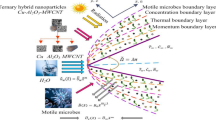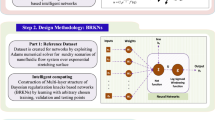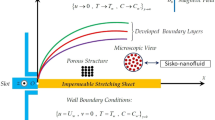Abstract
The current research examines the potential of the Adaptive Neuro-Fuzzy Inference System (ANFIS) technique in predicting the transport properties of a hybrid water-based nanofluid made of SWCNTs (single-walled carbon nanotubes) and MWCNTs (multi-walled carbon nanotubes) past a moving wedge with activation energy, radiation, and MHD (magnetohydrodynamic) effects. The flow problem under consideration has been theoretically characterised, and computation is accomplished by adopting the shooting strategy and the Runge–Kutta–Fehlberg fourth-fifth order (RKF45) numerical scheme. By utilizing the pertinent flow variables as inputs, three ANFIS models have been proposed to anticipate the skin friction coefficient (\({\widehat{S}}_{f}\)), Nusselt number (\({\widehat{H}}_{t}\)), and Sherwood number (\({\widehat{M}}_{t}\)). The ANFIS models’ performances are measured using statistical evaluation criteria. The estimated ANFIS outcomes and the simulated numerical values are in excellent accordance with the correlation coefficients (R) of 0.96499, 0.99596, and 0.975211 for \({\widehat{S}}_{f}\), \({\widehat{H}}_{t}\), and \({\widehat{M}}_{t}\), respectively. The provided ANFIS models are robust, efficient, and reliable, and they precisely forecast the results.









Similar content being viewed by others
Data Availability
Data will be available by made on request.
Abbreviations
- \(\widehat{u},\widehat{v}\) :
-
Velocity components
- \(x,y\) :
-
Space coordinates
- \({\widehat{u}}_{w}, {\widehat{u}}_{e}\) :
-
Velocity at the surface and far-field
- \(m\) :
-
Wedge parameter
- \(B\) :
-
Variable magnetic field
- \({\widehat{T}}_{w}, {\widehat{C}}_{w}\) :
-
Surface temperature and concentration
- \({\widehat{T}}_{\mathrm{fs}}, {\widehat{C}}_{\mathrm{fs}}\) :
-
Free stream temperature and concentration
- \({D}_{B}\) :
-
Brownian diffusion coefficient
- \({D}_{T}\) :
-
Thermophoretic diffusion coefficient
- \({k}_{r}\) :
-
Chemical reaction rate
- \({E}_{a}\) :
-
Modified arrhenius function
- \({k}^{*}\) :
-
Mean absorption coefficient
- \(f\) :
-
Dimensionless velocity
- \(M\) :
-
Magnetic parameter
- \(\mathrm{Pr}\) :
-
Prandtl number
- \(R\) :
-
Radiation parameter
- \(\mathrm{Nb}\) :
-
Brownian motion parameter
- \(\mathrm{Nt}\) :
-
Thermophoresis parameter
- \(\mathrm{Le}\) :
-
Lewis number
- \(\mathrm{Rc}\) :
-
Dimensionless chemical reaction rate
- \(E\) :
-
Activation energy parameter
- \({\widehat{S}}_{f}\) :
-
Skin friction coefficient
- \({\widehat{H}}_{t}\) :
-
Nusselt number
- \({\widehat{M}}_{t}\) :
-
Sherwood number
- \(\mathrm{Re}\) :
-
Reynolds number
- \(\beta\) :
-
Hartree pressure gradient
- \(\widehat{\Omega }\) :
-
Wedge angle
- \(\sigma\) :
-
Electrical conductivity
- \({n}_{0}\) :
-
Fitted rate constant
- \({\rho }_{\mathrm{hnf}}\) :
-
Density of hybrid nanofluid
- \({\mu }_{\mathrm{hnf}}\) :
-
Dynamic viscosity of hybrid nanofluid
- \({(\rho {C}_{p})}_{\mathrm{hnf}}\) :
-
Heat capacity of hybrid nanofluid
- \({k}_{\mathrm{hnf}}\) :
-
Thermal conductivity of hybrid nanofluid
- \({\varphi }_{1}, {\varphi }_{2}\) :
-
Nanoparticle volume fraction of SWCNT and MWCNT
- \(\zeta\) :
-
Similarity variable
- \(\psi\) :
-
Stream function
- \({\vartheta }_{f}\) :
-
Kinematic viscosity of fluid
- \({\sigma }^{*}\) :
-
Stefan-Boltzmann constant
- \(\theta\) :
-
Dimensionless temperature
- \(\phi\) :
-
Dimensionless concentration
- \(\gamma\) :
-
Moving wedge parameter
- \(\delta\) :
-
Temperature difference parameter
- \(f\) :
-
Fluid
- \(\mathrm{nf}\) :
-
Nanofluid
- \(\mathrm{hnf}\) :
-
Hybrid nanofluid
- \(w, fs\) :
-
Surface and free stream
- \({m}_{1},{m}_{2}\) :
-
SWCNT and MWCNT nanoparticle
References
Sajid, MU.; Ali, HM.: Thermal conductivity of hybrid nanofluids: A critical review. Int J Heat Mass Transf 126(A):211–234. (2018)
Guan, H.; Su, Q.; Wang, R.; Huang, L.; Shao, C.; Zhu, Z.: Why can hybrid nanofluid improve thermal conductivity more? A molecular dynamics simulation. J. Mol. Liq. 372, 121178 (2023)
Sulochana, C.; Aparna, S.R.; Sandeep, N.: Magnetohydrodynamic MgO/CuO-water hybrid nanofluid flow driven by two distinct geometries. Heat Transfer 49(6), 3663–3682 (2020)
Izady, M.; Dinarvand, S.; Pop, I.; Chamkha, A.J.: Flow of aqueous Fe2O3–CuO hybrid nanofluid over a permeable stretching/shrinking wedge: A development on Falkner-Skan problem. Chin. J. Phys. 74, 406–420 (2021)
Garia, R.; Rawat, S.K.; Kumar, M.; Yaseen, M.: Hybrid nanofluid flow over two different geometries with cattaneo-christov heat flux model and heat generation: A model with correlation coefficient and probable error. Chin. J. Phys. 74, 421–439 (2021)
Kakar, N.; Khalid, A.; Al-Johani, A.S.; Alshammari, N.: Melting heat transfer of a magnetized water-based hybrid nanofluid flow past over a stretching/shrinking wedge. Case Stud Therm Eng 30, 101674 (2022)
Ahmad, S.; Nadeem, S.: Analysis of activation energy and its impact on hybrid nanofluid in the presence of Hall and ion slip currents. Appl. Nanosci. 10(12), 5315–5330 (2020)
Shanmugapriya, M.; Sundareswaran, R.; Senthil, K.P.: Heat and mass transfer enhancement of MHD hybrid nanofluid flow in the presence of activation energy. Int. J. Chem. Eng. 2021, 9473226 (2021)
Kumar, R.S.V.; Alhadhrami, A.; Punith Gowda, R.J.; Naveen Kumar, R.; Prasannakumara, B.C.: Exploration of Arrhenius activation energy on hybrid nanofluid flow over a curved stretchable surface. Z Angew Math Mech. 101(12), e202100035 (2021)
Rekha, M.B.; Sarris, I.E.; Madhukesh, J.K.; Raghunatha, K.R.; Prasannakumara, B.C.: Activation energy impact on flow of AA7072-AA7075/water-based hybrid nanofluid through a cone, wedge and plate. Micromachines 13, 302 (2022)
Shivakoti, I.; Rodrigues, L.L.R.; Cep, R.; Pradhan, P.M.; Sharma, A.; Bhoi, A.K.: Experimental investigation and ANFIS-based modelling during machining of EN31 alloy steel. Materials 13, 3137 (2020)
Marjani, A.; Babanezhad, M.; Shirazian, S.: Application of adaptive network-based fuzzy inference system (ANFIS) in the numerical investigation of Cu/water nanofluid convective flow. Case Stud Therm Eng 22, 100793 (2020)
Babanezhad, M.; Behroyan, I.; Nakhjiri, A.T.; Marjani, A.; Shirazian, S.: Performance and application analysis of ANFIS artificial intelligence for pressure prediction of nanofluid convective flow in a heated pipe. Sci. Rep. 11, 902 (2021)
Sada, S.O.; Ikpeseni, S.C.: Evaluation of ANN and ANFIS modeling ability in the prediction of AISI 1050 steel machining performance. Heliyon 7, e06136 (2021)
Sinha, D.K.; Satavalekar, R.; Kasilingam, S.: Application of adaptive neuro-fuzzy inference system for evaluating compressive strength of concrete. Int J Fuzzy Logic Intell Syst 21(2), 176–188 (2021)
Armaghani, D.J.; Asteris, P.G.: A comparative study of ANN and ANFIS models for the prediction of cement-based mortar materials compressive strength. Neural Comput. Appl. 33, 4501–4532 (2021)
Zhang, G.; Band, S.S.; Ardabili, S.; Chau, K.-W.; Mosavi, A.: Integration of neural network and fuzzy logic decision making compared with bilayered neural network in the simulation of daily dew point temperature. Eng Appl Comput Fluid Mech 16(1), 713–723 (2022)
Elayarani, M.; Shanmugapriya, M.; Senthil, K.P.: Estimation of magnetohydrodynamic radiative nanofluid flow over a porous non-linear stretching surface: application in biomedical research. IET Nanobiotechnol. 13(9), 911–922 (2019)
Seenivasan, D.; Elayarani, M.; Shanmugapriya, M.: Heat and mass transfer analysis of Al2O3-water and Cu-water nanofluids over a stretching surface with thermo-diffusion and diffusion-thermo effects using artificial neural network. In: Trends in Mechanical and Biomedical Design. Lecture Notes in Mechanical Engineering pp. 417–434 (2020)
Gopi Krishna, S.; Shanmugapriya, M.; Senthil, K.P.: Prediction of bio-heat and mass transportation in radiative MHD Walter-B nanofluid using MANFIS model. Math. Comput. Simul. 201, 49–67 (2022)
Gopi Krishna S, Shanmugapriya M, Sundareswaran R, Senthil Kumar P.: MANFIS approach for predicting heat and mass transport of bio-magnetic ternary hybrid nanofluid using Cu/Al2O3/MWCNT nanoadditives. Biomass Conversion and Biorefinery 2022.
Santhi, M.; Suryanarayana Rao, K.V.; Sudarsana Reddy, P.; Sreedevi, P.: Heat and mass transfer characteristics of radiative hybrid nanofluid flow over a stretching sheet with chemical reaction. Heat Transfer 50(3), 2929–2949 (2021)
Jang, J.-S.R.: ANFIS: adaptive-network-based fuzzy inference system. IEEE Trans Syst Man Cybern 23(3), 665–685 (1993)
Jang, J-S.R.; Sun, C-T.; Mizutani, E.: Neuro-fuzzy and soft computing: a computational approach to learning and machine intelligence. New Jersey: Prentice Hall, Upper Saddle River; 1997.
Elayarani, M.; Shanmugapriya, M.; Senthil, K.P.: Intensification of heat and mass transfer process in MHD Carreau nanofluid flow containing gyrotactic microorganisms. Chem. Eng. Process. 160, 108299 (2021)
Funding
This research is not financially supported by any funding agencies.
Author information
Authors and Affiliations
Contributions
MS contributed to Conceptualization, Validation and Supervision. RS contributed to Investigation, Resources and Formal analysis. PSK contributed to Conceptualization, Validation and Supervision. ME contributed to Investigation, Methodology, and Writing—Original Draft.
Corresponding authors
Ethics declarations
Conflict of interest
Authors declares that no competing interests for this research article.
Ethical Approval
This article does not contain any studies involving animal or human participants performed by any of the authors.
Rights and permissions
Springer Nature or its licensor (e.g. a society or other partner) holds exclusive rights to this article under a publishing agreement with the author(s) or other rightsholder(s); author self-archiving of the accepted manuscript version of this article is solely governed by the terms of such publishing agreement and applicable law.
About this article
Cite this article
Shanmugapriya, M., Sundareswaran, R., Kumar, P.S. et al. An ANFIS Approach for Predicting MHD Radiative Hybrid Nanofluid Flow Attributes with Activation Energy Effect. Arab J Sci Eng 48, 16373–16387 (2023). https://doi.org/10.1007/s13369-023-08260-3
Received:
Accepted:
Published:
Issue Date:
DOI: https://doi.org/10.1007/s13369-023-08260-3




